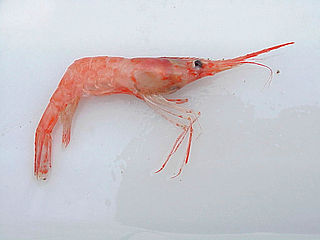
David Starr Jordan was the founding president of Stanford University, serving from 1891 to 1913. He was an ichthyologist during his research career. Prior to serving as president of Stanford University, he had served as president of Indiana University from 1884 to 1891.

The Cyclopteridae are a family of marine fishes, commonly known as lumpsuckers or lumpfish, in the order Scorpaeniformes. They are found in the cold waters of the Arctic, North Atlantic, and North Pacific oceans. The greatest number of species are found in the North Pacific. The family name Cyclopteridae derives from the Greek words κύκλος (kyklos), meaning "circle", and πτέρυξ (pteryx), meaning "wing" or "fin", in reference to the circle-shaped pectoral fins of most of the fish in this family.

Cyclopterus lumpus, the lumpsucker or lumpfish, is a species of marine ray-finned fish belonging to the family Cyclopteridae, the lumpsuckers or lumpfish. It is the only member of the monospecific genus Cyclopterus. It is found in the North Atlantic and adjacent parts of the Arctic Ocean, ranging as far south as Chesapeake Bay on the North American coast and Spain on the European coast. The species has been reported twice in the Mediterranean Sea, off Croatia in 2004 and Cyprus in 2017.

Astyanax jordani is a freshwater fish of the characin family of order Characiformes, native to Mexico. It is sometimes called the cave tetra, or by its local Spanish name tetra ciego.

Cleaner fish are fish that show a specialist feeding strategy by providing a service to other species, referred to as clients, by removing dead skin, ectoparasites, and infected tissue from the surface or gill chambers. This example of cleaning symbiosis represents mutualism and cooperation behaviour, an ecological interaction that benefits both parties involved. However, the cleaner fish may consume mucus or tissue, thus creating a form of parasitism called cheating. The client animals are typically fish of a different species, but can also be aquatic reptiles, mammals, or octopuses. A wide variety of fish including wrasse, cichlids, catfish, pipefish, lumpsuckers, and gobies display cleaning behaviors across the globe in fresh, brackish, and marine waters but specifically concentrated in the tropics due to high parasite density. Similar behaviour is found in other groups of animals, such as cleaner shrimps.
Leptopelis jordani is a species of little-known frog in the family Arthroleptidae. Common name Congulu forest treefrog has been coined for it.

The red-cheeked salamander, also known as the Jordan's salamander, Jordan's redcheek salamander, or Appalachian woodland salamander, is a species of salamander in the family Plethodontidae. It is endemic to the Appalachian Mountains in the eastern United States.

The Gulf grouper is a species of marine ray-finned fish, a grouper from the subfamily Epinephelinae which is part of the family Serranidae, which also includes the anthias and sea basses. It is endemic to Mexico.

Enneanectes jordani, known commonly as the redbelly triplefin and the mimic triplefin, is a species of triplefin blenny from the northern Caribbean Sea and the Gulf of Mexico south as far as Venezuela. The specific name honours the American ichthyologist David Starr Jordan (1851-1931). Some authorities consider the synonym Enneanectes pectoralis to be a valid species.

Pandalus is a genus of shrimp in the family Pandalidae. Members of the genus are medium-sized and live on or near the seabed. Some species are the subject of commercial fisheries and are caught by trawling. One species, Pandalus montagui, lives in association with the reef-building polychaete worm, Sabellaria spinulosa.

The smooth lumpfish is a species of marine ray-finned fish belonging to the family Cyclopteridae, the lumpfishes and lumpsuckers. This species is found in the northern Pacific Ocean. It is the only species in the monospecific genus Aptocyclus.
Cyclopteropsis is a genus of marine ray-finned fishes belonging to the family Cyclopteridae, the lumpfishes or lumpsuckers. These small lumpfishes are found in the North Pacific and Arctic Oceans.
Karusasaurus jordani, Jordan's girdled lizard or the Namibian girdled lizard, is a species of lizard in the family Cordylidae. It is a small, spiny lizard found in Namibia.
Cyclopteropsis bergi is a species of lumpfish native to the Northwest Pacific, where it is found at depths of 20 to 200 m. This species reaches 7 cm in total length and occurs in the Bering Sea, the Sea of Okhotsk, and the Sea of Japan where it may be found off of North Korea and Sado Island. In 2011, a single individual of the species was also reported from Sokcho, South Korea.
Cyclopteropsis brashnikowi is a species of lumpfish native to the Sea of Okhotsk and the Northwest Pacific off of the Kuril Islands, where it is found at a depth of 30 to 303 m. Adult individuals of the species have been noted to resemble the related species C. popovi, suggesting that the two species names may be synonymous. It is of disputed classification, being considered a species of Eumicrotremus by some authors, although sources such as FishBase, WoRMS, and ITIS do not follow this classification.
Cyclopteropsis lindbergi is a species of lumpfish native to the Bering Sea, the Sea of Okhotsk, and the Sea of Japan. It is found at a depth range of 20 to 200 m, and it may reach 7 cm in total length.
Cyclopteropsis mcalpini, also known as the Arctic lumpsucker, is a species of lumpfish known only from the Arctic Ocean. It has been found in the Barents Sea and off the coast of northwestern Greenland, where it occurs at a depth range of 109 to 329 m. It is a small fish, growing to 7.5 cm in total length. Arctic lumpsuckers are reported to usually lay between 60 and 70 eggs, which are deposited in protected areas such as empty shells.
Cyclopteropsis popovi is a species of lumpfish native to the Northwest Pacific. It can be found from the Sea of Okhotsk to the Pacific coasts of the northern Kuril Islands. Some specimens of the related species C. brashnikowi suggest that the two might be synonymous, in which case C. brashnikowi would be considered the senior synonym.

Eumicrotremus spinosus, commonly known as the Atlantic spiny lumpsucker, is a species of lumpfish native to the Arctic and North Atlantic.
Proeumicrotremus soldatovi, also known as Soldatov's lumpsucker, is a species of lumpfish native to the Northwest Pacific, and the only species in the genus Proeumicrotremus. It is known from the Sea of Okhotsk, where it can be found at depths of 10 to 350 m. It reaches 26 cm in total length, making it larger than average for a lumpfish. It was previously considered a species of Eumicrotremus until a morphology-based revision in 2020 concluded that it represents the only known species of a distinct genus.










